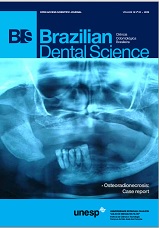What is the best protocol for bonding resin-modified glass ionomer cement to composite resin?
DOI:
https://doi.org/10.14295/bds.2015.v18i2.1077Abstract
Objective: The objective of this study was to evaluate the bond strength of resin-modified glass ionomer cement (RMGIC) to composite resin considering the use of conventional and self-etching adhesive systems. Material and Methods: 60 RMGIC blocks (Riva, SDI) measuring 4 x 4 x 4 mm. were constructed. On the blocks, the application of different protocols of adhesive systems (n = 10) was carried out: Group 1 (Control) - without application of adhesive agent; Group 2 - 37% phosphoric acid + conventional adhesive agent Single Bond 2; Group 3 - conventional adhesive agent Single Bond 2; Group 4 – conventional adhesive agent Scotch Bond Multi-Purpose; Group 5 - self-etching adhesive Clearfil SE Bond; Group 6: self-etching adhesive Optibond Allin-One. Next, resin composite blocks measuring 4 x 4 x 4 mm were constructed (Venus, Heraeus Kulzer). The specimens were cut to obtain sticks which were submitted to microtensile bond strength test in a universal testing machine. The data were submitted to ANOVA and Tukey test (5%). Results: ANOVA showed a value of p < 0.05, which indicated significant differences between the groups (in Mpa): Group 2 - 32.83; Group 5 - 31.2; Group 3 - 25,15b; Group 6 - 22.92; Group 4 - 22.15; Group 1 - 13.84. The analysis of fracture mode demonstrated that there was a predominance of adhesive and mixed fractures for all groups. Conclusion: The protocols of acid etching + conventional adhesive system Single Bond 2 (Group 2) or self-etching adhesive system Clearfil SE Bond (Group 5) increased the bond strength of RMGIC to the composite resin. The presence of an adhesive layer between the two materials tended to improve the bonding of RMGIC to composite resin.
Downloads
Downloads
Published
How to Cite
Issue
Section
License
Brazilian Dental Science uses the Creative Commons (CC-BY 4.0) license, thus preserving the integrity of articles in an open access environment. The journal allows the author to retain publishing rights without restrictions.
=================




























